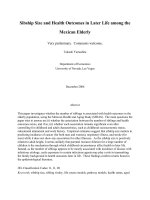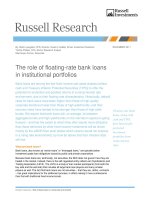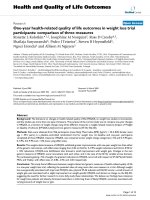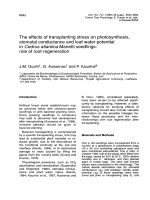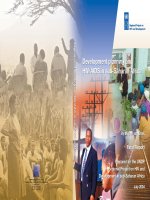Improving health, nutrition and population outcomes in sub saharan africa the role of the world bank (sub saharan africa and the world bank)
Bạn đang xem bản rút gọn của tài liệu. Xem và tải ngay bản đầy đủ của tài liệu tại đây (2.66 MB, 300 trang )
Improving
Health, Nutrition,
and Population
Outcomes in
Sub-Saharan Africa
The Role of the
World Bank
Improving Health, Nutrition,
and Population Outcomes in
Sub-Saharan Africa
The Role of the World Bank
Improving Health, Nutrition,
and Population Outcomes in
Sub-Saharan Africa
The Role of the World Bank
Washington, D.C.
© 2005 The International Bank for Reconstruction and Development / The World Bank
1818 H Street, NW
Washington, DC 20433
Telephone: 202-473-1000
Internet: www.worldbank.org
E-mail:
All rights reserved.
The findings, interpretations, and conclusions expressed herein are those of the author(s) and do not
necessarily reflect the views of the Board of Executive Directors of the World Bank or the governments
they represent.
The World Bank does not guarantee the accuracy of the data included in this work. The boundaries,
colors, denominations, and other information shown on any map in this work do not imply any judgment on the part of the World Bank concerning the legal status of any territory or the endorsement or
acceptance of such boundaries.
Rights and Permissions
The material in this work is copyrighted. Copying and/or transmitting portions or all of this work without permission may be a violation of applicable law. The World Bank encourages dissemination of its
work and will normally grant permission promptly.
For permission to photocopy or reprint any part of this work, please send a request with complete
information to the Copyright Clearance Center, Inc., 222 Rosewood Drive, Danvers, MA 01923, USA,
telephone 978-750-8400, fax 978-750-4470, www.copyright.com.
All other queries on rights and licenses, including subsidiary rights, should be addressed to the
Office of the Publisher, World Bank, 1818 H Street NW, Washington, DC 20433, USA, fax 202-5222422, e-mail
Library of Congress Cataloging-in-Publication Data
World Bank.
Improving health, nutrition, and population outcomes in Sub-Saharan Africa : the role of
The World Bank / the World Bank.
p. cm.
Includes bibliographical references and index.
ISBN 0-8213-5963-0
Public health—Africa, Sub-Saharan. 2. Medical economics—Africa, Sub-Saharan. 3.
World Bank. I. Title.
RA552.A357W67 2004
362.1'0967—dc22
2004053004
Cover photos courtesy of Dr. S. René Salgado.
Contents
Preface
xiii
Acknowledgments
xix
Abbreviations and Acronyms
xxi
Executive Summary
xxv
Chapter 1: Today’s Realities
Health, nutrition, and population outcomes are advancing
too slowly to reach the Millennium Development Goals
Africa’s health sector faces special challenges
Conclusion
Chapter 2: Why and How the World Bank Should Be
Involved
Poverty and health in Sub-Saharan Africa
are interrelated
Health outcomes are affected in complex ways by a broad
set of determinants
The World Bank should focus its work on its areas of
comparative advantage
Conclusion
1
1
17
25
27
28
36
40
48
Chapter 3: Improving Health, Nutrition, and Population
Outcomes through Economic and Fiscal Policy
49
The Bank can help to ensure that public expenditure
recognizes the role of health, nutrition, and population
in poverty reduction
50
Improved health outcomes and reduced poverty require
more effective policies, implementation, and resource
allocation within the sector
57
v
CONTENTS
The health sector could benefit from working more closely
with central ministries
Health sector expertise can help ensure that economic and
fiscal policy contributes to health outcomes
Conclusion
Chapter 4: Multisector Action to Improve Health,
Nutrition, and Population Outcomes
Actions across multiple sectors can affect health, nutrition,
and population outcomes
The response to HIV/AIDS sets an example
Reducing malnutrition requires multisector action
Multisector action can reduce disability and death
from many causes
Conclusion
Chapter 5: Effective Systems for Delivering Health,
Nutrition, and Population Interventions
Health workforce limitations pose the
greatest challenges to health care delivery
Access to and use of pharmaceuticals must be improved
The institutional and organizational
frameworks must also be right
The private sector can play an important role in
service delivery
Household and community factors also affect
system effectiveness
Conclusion
Chapter 6: Sustainable Financing of Health, Nutrition,
and Population Interventions
Spending on health, nutrition, and population is lower in
Africa than anywhere else
Countries are employing a range of strategies to manage
health financing
Countries are trying to improve the efficiency and equity
of health financing
Conclusion
vi
63
67
71
73
74
77
80
82
93
95
97
105
115
122
129
132
135
136
146
155
164
CONTENTS
Chapter 7: Implications for World Bank Operations
World Bank operations in Sub-Saharan Africa aim to achieve
sustainable improvements
Lending operations and resource transfers are taking a new
approach
Nonlending opportunities can also be exploited
The World Bank cannot achieve its objectives without
partnerships
Conclusion
165
Notes
187
References
195
Index
221
Figures
1.1 Few African countries are on track to achieve the
MDGs for infant and child mortality and malnutrition
1.2 Under-five mortality has declined more slowly in
Africa than in South Asia
1.3 Life expectancy at birth declined in the 1990s
1.4 Poor and rich experience big differences in under-five
mortality
1.5 Poor and rich experience big differences in under-three
mortality
1.6 The mortality-plus-disability gap is even wider than
the mortality gap
1.7 The burden of disease for the four leading causes
of death is related to the prevalence of AIDS in
Sub-Saharan Africa
1.8 Africa’s share of child mortality is rising
1.9 World population under age 15
1.10 Will Africa have 1.8 billion people in 2050?
1.11 Not many married women use modern contraception
1.12 Sub-Saharan Africa has the highest fertility rates
1.13 The unmet demand for family planning is great in
Sub-Saharan Africa
1.14 Africa has the fewest physicians
1.15 Tuberculosis cases are rising fast in Sub-Saharan Africa
165
166
176
182
186
2
4
5
5
6
7
8
10
12
13
15
15
17
23
24
vii
CONTENTS
1.16 Africa has more orphans than Asia or Latin America
2.1 Health and poverty are linked in a cycle
2.2 Africa’s window of opportunity is still decades away
as dependency rates remain high
2.3 Health, nutrition, and population outcomes have many
determinants
2.4 The Bank’s institutional comparative advantage overlaps
with the most critical strategic HNP issues faced by
client countries in Africa today
2.5 The World Bank can help integrate the matrix of
individual health care initiatives
3.1 Health expenditures in Sub-Saharan Africa were flat
in the 1990s
3.2 The incidence of illness was lower among children
enrolled in PROGRESA
3.3 Public spending on health correlates with under-five
mortality rates
3.4 Higher expenditures on health do not always result in
better health outcomes
3.5 Few nursing staff are in rural areas
3.6 A number of African countries have reduced or
waived taxes and tariffs on bednets, netting material,
and insecticide
3.7 Cigarette consumption in South Africa plunges with
higher prices
3.8 High proportions of health workers intend to
migrate
4.1 The environment-related burden of disease is high in
Sub-Saharan Africa
4.2 Environmental factors cause great health damage in
developing countries
4.3 The Benin multisector AIDS project supports more
activities in civil society
4.4 Malnutrition in the Senegal Community Nutrition
Project was reduced from 60–70 percent to less than
30 percent in six months
viii
25
28
32
38
41
44
51
55
58
59
61
66
67
70
76
77
78
82
CONTENTS
4.5
4.6
4.7
5.1
5.2
5.3
5.4
5.5
5.6
5.7
6.1
6.2
6.3
6.4
6.5
7.1
7.2
7.3
7.4
Sanitation and water coverage are limited in Africa
More Africans are dying on the roads or suffering
disabilities
Mother’s education is associated with lower infant
mortality
Tanzania will meet only half its staff needs by 2015
The percentage of overseas-trained nurses registered
in the United Kingdom is increasing
Most Nigerian registered physicians are in private
hospitals
Per capita pharmaceutical expenditures are lowest
in Africa
Prices for antiretrovirals are declining
Botswana traditional healers far outnumber physicians,
2001
Community-directed treatment can improve control of
onchocerciasis, schistosomiasis, and lymphatic filariasis
The flow of funds for health in a “typical” Sub-Saharan
African country
Households account for the largest share of spending
on health in Tanzania
Estimated development assistance for health was
significant in Sub-Saharan Africa, 1998–2000
Sub-Saharan Africa had the largest proportion of
World Bank–supported health, nutrition, and population
projects in fiscal 2004
Patterns of use changed when fees were abolished in
Uganda
SWAps vary in application, but share building blocks
The traditional project cycle has sequential processing
steps
A focus on results demands a more continuous and
flexible use of Bank tools
The World Bank has defined a new strategic framework
for assistance to Africa
85
87
91
99
100
102
106
110
124
131
137
138
141
142
153
168
169
170
174
ix
CONTENTS
Tables
1.1 Under-five mortality rates worsened in many African
countries, 1997–2002
1.2 HIV/AIDS affects Sub-Saharan Africa disproportionately
(December 2002)
1.3 All scenarios project a shortfall in resources for
population and reproductive health (billions of US$)
2.1 Population indicators are high in Africa (selected
countries)
2.2 Households in Zimbabwe with an AIDS death
suffered reduced crop production
3.1 The public resources available for health following
debt relief “decision points” increased in selected
heavily indebted poor countries
4.1 Health outcomes are strongly affected by interventions
outside the health sector
4.2 Government agencies other than ministries of health
have responsibilities that relate to health outcomes
4.3 Changes in food imports and food production in
Sub-Saharan Africa are dramatic
4.4 Urban and peri-urban water and sanitation investments
are cost-effective
4.5 Motor vehicle accidents in Africa contribute
significantly to the burden of disease (fatalities per
10,000 vehicles in 1995)
4.6 On-site assessment of vaccine refrigerators at rural
primary health care facilities in the Eastern Transvaal
shows dramatic correlation of function to energy source
5.1 Measurable factors affect the health sector’s interactions
with clients
5.2 Average monthly salaries for junior doctors are low
(1999 US$)
5.3 Various pharmaceutical supply systems exist in Africa
5.4 Africa has several types of private providers
6.1 Revenues from cost recovery vary across African
countries
6.2 Benefit incidence of public spending on health in
selected countries shows the disparity between rich
and poor
x
4
9
16
32
34
53
74
75
81
85
87
90
96
97
108
123
140
158
CONTENTS
Boxes
1.1 Five conditions account for more than half of all deaths
3
1.2 Rapid population growth in Sub-Saharan Africa leads
to high dependency ratios
13
1.3 “Feel Good” Risks
21
1.4 New Government Institutions Lack Accountability
22
2.1 The Millennium Development Goals
36
2.2 Households are the main producers of health
37
2.3 The Malawi paradox: Health services alone do not
determine outcomes
38
2.4 The nature of health investments is long term and complex 40
2.5 How do global priorities respond to country priorities?
44
3.1 Conditional cash transfers improve health and nutrition
55
3.2 What is required to more effectively address health
in PRSPs?
56
3.3 Reducing taxes and tariffs on insecticide-treated bednets:
How fiscal policy can affect health outcomes
66
4.1 The highway sector in Ethiopia is responding to
HIV/AIDS
79
4.2 Nutrition interventions can be successful
83
4.3 Brazil has significantly reduced accidents and deaths
through road safety
89
4.4 Health interventions in schools succeed in Tanzania
92
5.1 Health systems extend beyond the ministry of health
97
5.2 The migration of health professionals is a severe problem 99
5.3 Push and pull factors contribute to the medical brain
drain out of Africa
100
5.4 African countries partner with international drug
manufacturers
112
5.5 Eritrea says, “Thanks, but no thanks” to drug donations 113
5.6 Health sector decentralization has potential advantages
118
5.7 Hospital autonomy differs from privatizing
121
5.8 Health reform is intensely political
122
5.9 Malawi’s government partners with mission health
services
125
5.10 The private sector has an advantage in promoting
behavior change
127
5.11 Accreditation improves the quality of drug dispensing
in Tanzania
129
xi
CONTENTS
6.1
6.2
6.3
6.4
6.5
6.6
7.1
7.2
7.3
7.4
xii
Grant financing has been supported for the first time
under IDA 13
Absorption of external financing can be increased by
working outside the public sector
Tanzania’s National Health Insurance Fund may
provide a model
The Addis Ababa Forum identified principles for cost
sharing in health and education
Community financing faces multiple challenges
The Bank and client countries need to make rational
investments in new medical technology
The Bank’s strategy for Africa outlines principles for
a new aid relationship
A PRSP can incorporate health, nutrition, and
population effectively
The World Bank Institute shares knowledge on health,
nutrition, and population in Africa
APOC represents a unique health partnership for the
World Bank
142
143
149
151
155
161
168
177
180
185
Preface
T
HIS REPORT AIMS TO SET A NEW STRATEGIC DIRECTION FOR THE
World Bank’s work in health in Africa. It is now more than 10
years since we issued the “Better Health in Africa” report, and
much has changed in Africa, not always for the better. Some of that
report’s findings and recommendations still hold, as do some from the
World Development Report 1993: Investing in Health (World Bank
1993b), but most have yielded to the new health realities of Africa,
including the devastating AIDS epidemic.
Many of our African client countries are searching for the right strategic answers to address their long-term health challenges and are requesting the Bank’s support in those efforts. While this report provides a comprehensive overview and analysis of the challenges, it sometimes raises
more questions than it answers by presenting a range of strategic options
that will need to be tailored to the circumstances of each country or
region. The report is intended to assist in setting a strategic agenda for
finding the right answers through country-level analytical work and evaluation of global and regional experiences. It summarizes and consolidates
a multiyear effort begun in 2002 by the Africa Region’s Health, Nutrition,
and Population Family (World Bank 2002f) to strengthen the knowledge
base and consensus on critical challenges in health development in Africa
and to focus lending and analytical work around critical strategic challenges where the Bank has a comparative advantage. It also seeks to
encourage efforts to organize operations and staff to more efficiently and
effectively support client countries and to complement efforts by other
organizations to improve health outcomes among the poor in Africa.
With the Bank’s commitment to the Millennium Development Goals,
the impact of our work is also measured in terms of life expectancy, child
and maternal mortality, malnutrition, access to reproductive health care,
and reduction in the spread of HIV. This has implications for both
Poverty Reduction Strategies and Country Assistance Strategies.
Although notable successes have been realized in some areas
and some countries, progress in health outcomes in Africa overall is not
xiii
P R E FAC E
making the gains needed to achieve economic growth and reduce
poverty: in absolute numbers, household poverty has almost doubled
over the last 20 years; illness, malnutrition, high fertility, and premature
death have become increasingly important and central determinants of
poverty; infant mortality remains the highest in the world; under-five
mortality has worsened in a quarter of African countries; nutritional
status has not improved over the past two decades; and the majority
of African countries still have high fertility and population growth rates.
An overarching challenge is AIDS, which affects Africa more than
any other region and is demonstrating how disease can dramatically
undermine macroeconomic outcomes in addition to having devastating
human costs.
At the same time, there is a divergence between the health, nutrition,
and population (HNP)1 strategic priorities of the least developed countries of the world (most of the countries in the Africa Region, plus some
20 outside Africa2) and the issues receiving attention from international
development institutions. The systemic, financial, and behavioral challenges to improving health care in Sub-Saharan Africa are not prominent
on the agendas of academic and research institutions, and the bulk of the
work on health systems over the past decade has focused on high- and
middle-income countries. Recently, international attention to communicable diseases, specifically AIDS, tuberculosis, and malaria, has surged.
Nutrition and population issues in Africa deserve similar attention,
because poor nutritional status and high rates of fertility contribute to
deaths from communicable disease, impede higher educational attainment, and reduce economic growth.
The overall goal of the health group in the Bank’s Africa Region is to
help client countries to achieve sustainable improvements in their health
outcomes, particularly for the poor. This report, prepared by a large
cross-section of the health staff of the World Bank’s Africa Region, recognizes that macroeconomic development and progress in health are
linked, and that having a sustainable impact on communicable disease,
nutrition, and population objectives requires sound human and institutional capacity in Africa’s health sector. World Bank interventions should
therefore aim to strengthen the economic, institutional, and human
capacity of client countries to identify and prioritize their health concerns, design locally appropriate policies that build on global and
regional knowledge and experience, mobilize domestic resources and
international development assistance, implement effective economic and
xiv
P R E FAC E
health reform strategies, and monitor and evaluate the impact of those
strategies on health outcomes among the poor.
Three areas are identified as strategic priorities for Bank interventions:
integration of macroeconomic policies and health policies; multisector
policies and actions outside the health sector that have major health
effects (female literacy, water, electricity); and health system strengthening, including equitable and sustainable health financing, health economics, and health insurance modalities. Three mechanisms for intervention
are also highlighted: resource transfer, knowledge transfer and policy
advice, and monitoring and evaluation. Resource transfer, primarily
health investment operations, already receives the most attention. This
report proposes ways to better position the health staff in Africa to support knowledge transfer through lending and nonlending tasks and by
strengthening partnerships to ensure complementary activities.
Poverty Reduction Strategies, the Highly Indebted Poor Countries
(HIPC) Initiative, the Comprehensive Development Framework, and a
greater appreciation for regional approaches and regional collaboration
are all changing the environment in which development interventions are
occurring. This new environment provides unique opportunities to
address longstanding constraints on health objectives, but it also challenges us to ensure that the health sector contributes to poverty reduction
through these new approaches.
The report is not intended to be the Health, Nutrition, and Population
Strategy for Africa. Health sector strategies need to focus on the country
level, and while Bank-defined strategies may influence and guide staff,
partners, and client countries, they do not directly translate into operations on the ground. Thus the report offers a range of strategic options
for clients, improves the quality of knowledge and advice to clients, and
strengthens the ability of Bank staff to respond to the specific needs of
each client country in the Africa Region.
The Africa Region has initiated separate working groups for several
critical areas identified in the report:
■
■
■
■
■
■
Health economics and financing
The public-private mix and partnerships
The health workforce crises
Pharmaceutical challenges
Malnutrition risks
Population and reproductive health perspectives
xv
P R E FAC E
Each group is headed by senior Africa Region HNP staff and
addresses such issues as health insurance and community financing, contracting out, decentralizing and privatizing through partnerships, the crisis in health personnel, high fertility and low contraceptive prevalence,
the challenges of providing the right drugs at the right time and place,
and how to reverse the trends of stunting. Working groups are also being
established for macroeconomics and health and for multisector
approaches.
While these areas reflect the core of the strategic work program, they
are flanked by two equally important undertakings that will help to illuminate the key health challenges in Africa. One is the comprehensive
analysis of death and disease problems across Africa, under the Disease
and Mortality in Sub-Saharan Africa (DMSSA) project. The last similar
overview was performed almost 15 years ago. The DMSSA will be the
first comprehensive treatise on death and disease in Africa since the onset
of HIV/AIDS changed the continent’s epidemiology. The work is being
carried out mostly by African scientists, and the results are expected to be
published next year. This work should provide a solid evidence base to
guide the efforts of African countries, the Bank, and others.
The second is the Bank’s Africa Region’s Country Status Reports
(CSRs), which have been expanded to include HNP issues. Health CSRs,
guided and informed by DMSSA evidence and the “strategic options”
products of the working groups, are essential tools for translating
regional findings and options to the country level and subsequent lending operations.
This report also identifies strategic areas in which we need to acquire
new skills and expertise and considers how most effectively to employ
new instruments and staff. As such, this work is intended to guide Bank
sector managers and country directors in the deployment of HNP staff in
Africa and to inform the relationship between the Bank-wide Human
Development Network and the Africa Region.
Much of the Africa HNP strategic options work program (2002–2007)
is carried out thanks to the generous financial support of the Netherlands
Government under the Bank-Netherlands Partnership Program (BNPP),
complemented by Bank budgets for the Africa Region. While all tasks
are managed by senior World Bank health staff, this report highlights the
importance of engaging both African national partners and international
partners in this effort. The report is quite clear on the importance of limiting the Bank’s role to health sector reform areas in which the Bank has
xvi
P R E FAC E
a comparative advantage. Where it does not, its international and
national partners (particularly the World Health Organization, the United
Nations Children’s Fund, the Global Fund to Fight AIDS, Tuberculosis
and Malaria, African universities and health research institutes, and the
private sector) are critical to a comprehensive and consistent effort to
assist African client countries in developing strategies to improve the
health outcomes of the poor.
Ok Pannenborg
Senior Advisor for Health, Nutrition, and Population
Africa Region
xvii
Acknowledgments
T
HEALTH, NUTRITION,
and Population staff of the World Bank’s Africa Region. The
work was managed by Julie McLaughlin, Lead Health Specialist, and was guided by Ok Pannenborg, Senior Advisor for Health, Nutrition, and Population. Many staff, former staff, and consultants have contributed to the text, most notably Ousmane Bangoura, David Berk,
Shiyan Chao, Gilles Dussault, Ed Elmendorf, Kathleen Finn, Sundararajan Gopalan, Ramesh Govindaraj, Bernhard Liese, Tonia Marek,
John May, Oscar Picazo, Khama Rogo, Agnes Soucat, and Adam
Wagstaff. Bank staff, partners, and clients have participated in multiple
meetings held over the past two years to reach consensus on the key messages. Production, design, research, and editing were supported by Elsie
Maka, Anne-Sophie Ville, Hui Xiao, Ying Zhou, and Communications
Development Incorporated.
We are also grateful to internal and external reviewers who provided
comments on various drafts, including Harold Alderman, Jacques
Baudouy, Eduard Bos, Logan Brenzel, Marito Garcia, Alan Gelb,
Demissie Habte, Philip Hedger, John Lambert, Jean-Pierre Manshande,
Joyce Msuya, Muhammad Pate, Anne Maryse Pierre-Louis, Rosemary
Sunkutu, Christopher Walker, Rufaro Chatora of the WHO Africa
Regional Office, Anno Galema of the Netherlands Ministry of Foreign
Affairs, David Peters of the Johns Hopkins Bloomberg School of Public
Health, Pia Rockhold of the Danish Ministry of Foreign Affairs, and
Allan Schapira of WHO/Geneva.
Much of the Africa HNP strategic options work program
(2002–2007) has been carried out thanks to the generous financial support of the Netherlands Government under the Bank-Netherlands Partnership Program (BNPP).
HIS PUBLICATION HAS BEEN PRODUCED BY THE
xix
Abbreviations and Acronyms
AAI
ACT
ADDO
APL
APOC
ARI
ARV
AU
BCC
CBO
CDC
CDD
CESAG
CHAM
CMH
CMS
CPIA
CPR
DAH
DALE
DALY
DDT
DEC
DHS
DOTS
DPO
DRA
ECA
ECD
ECOWAS
EPI
FAO
FRESH
Uganda’s Accelerating Access Initiative
Artemisinin-Based Combination Treatment
Accredited Drug Dispensing Outlet
Adaptable Program Loan/Credit
African Programme for Onchocerciasis Control
Acute Respiratory Infection
Anti-Retroviral
African Union
Behavior Change Communication
Community-Based Organization
U.S. Centers for Disease Control and Prevention
Community Driven Development
Centre Africain d’Etudes Superieures en Gestion
Christian Health Association of Malawi
Commission on Macroeconomics and Health
Central Medical Stores
Country Policy and Institutional Assessment
Contraceptive Prevalence Rate
Development Assistance for Health
Disability-Adjusted Life Expectancy
Disability-Adjusted Life Year
Dichlor-diphenyl-drichloroethane
Development Economics Vice Presidency
Demographic and Health Survey
Direct Observed Treatment Short course
Drug Procurement Office
Drug Regulatory Authority
UN Economic Commission for Africa
Early Child Development
Economic Community of West African States
Expanded Programme on Immunization
Food and Agriculture Organization of the United States
Focusing Resources on Effective School Health
xxi
A B B R E V I AT I O N S A N D A C R O N Y M S
GAIN
GAVI
GDP
GFATM
GMP
GNP
GTZ
HIPC
HNP
ICB
ICR
IDRC
IFC
IMCI
IMF
IMR
IPC
IRD
ITN
JLI
MAP
MDGs
MICS
MOH
MTEF
NEPAD
NGO
NHA
NHIF
OAU
OECD
OED
ORS
ORT
PER
PhRM
PPP
PRSC
xxii
Global Alliance for Improved Nutrition
Global Alliance for Vaccines and Immunization
Gross Domestic Product
Global Fund to Fight AIDS, Tuberculosis and Malaria
Good Manufacturing Practices
Gross National Product
Deutsche Gesellschaft für Technische Zusammenarbeit
Heavily Indebted Poor Countries Initiative
Health, Nutrition and Population
International Competitive Bidding
Implementation Completion Report
Canadian International Development Research Center
International Finance Corporation
Integrated Management of Childhood Illness
International Monetary Fund
Infant Mortality Rate
Interagency Pharmaceutical Coordination Group
Institut de Recherche Pour Le Développement
Insecticide Treated Net
Joint Learning Initiative
Multi-Country HIV/AIDS Project
Millennium Development Goals
Multiple Indicator Cluster Survey
Ministry of Health
Medium-Term Expenditure Framework
New Partnership for Africa’s Development
Nongovernmental Organization
National Health Account
National Health Insurance Fund in Tanzania
Organization of African Unity
Organisation for Economic Co-operation and
Development
Operations Evaluation Department
Oral Rehydration Salts
Oral Rehydration Therapy
Public Expenditure Review
Pharmaceutical Research and Manufacturers of America
Public-Private Partnership
Poverty Reduction Support Credit
A B B R E V I AT I O N S A N D A C R O N Y M S
PRSP
PRS
R&D
RBM
SADC
SARS
SEAM
SSA
SSATP
STD
STI
SWAp
TA
TB
TBA
TDR
TFDA
TFR
UN
UNAIDS
UNDP
UNESCO
UNFPA
UNICEF
USAID
WARDA
WBI
WDR
WFP
WHO
WTO
ZEDAP
Poverty Reduction Strategy Paper
Poverty Reduction Strategy
Research and Development
Roll-Back-Malaria Partnership
Southern African Development Community
Severe Acute Respiratory Syndrome
Strategies for Enhancing Access to Medicines
Sub-Saharan Africa
Sub-Saharan Africa Transport Policy program
Sexually Transmitted Disease
Sexually Transmitted Infection
Sector-Wide Approach
Technical Assistance
Tuberculosis
Traditional Birth Attendant
Special Program for Research and Training in
Tropical Disease
Tanzanian Food and Drugs Authority
Total Fertility Rate
United Nations
Joint United Nations Programme on HIV/AIDS
United Nations Development Program
United Nations Educational, Scientific and Cultural
Organization
United Nations Population Fund
United Nations Children’s Fund
United States Agency for International Development
West African Rice Development Association
World Bank Institute
World Development Report
World Food Program
World Health Organization
World Trade Organization
Zimbabwe Essential Drugs Action Programme
xxiii


